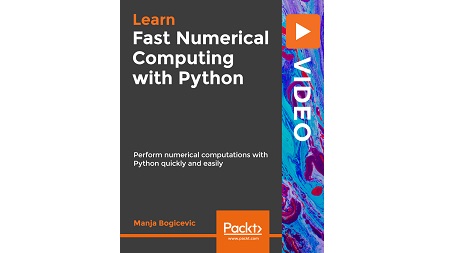
English | MP4 | AVC 1920×1080 | AAC 48KHz 2ch | 3h 17m | 624 MB
Get to grips with aspects of numerical computing and understand NumPy, the powerful numerical computing module, using Python!
Performing numerical computations using conventional Python methods is inefficient as complex calculations can take their toll on your system’s performance. However, NumPy, the core library for scientific computing in Python, helps keep computations fast and lets your system perform efficiently.
This course adopts a step-by-step approach where you learn through live examples. You will learn numerical computations by performing them! Gain the skills you need to become a better Python developer or data scientist. Beginning with NumPy’s arrays and functions, you’ll master linear algebra concepts, perform vector and matrix math operations, and use NumPy in Python (using quick and easy techniques) to derive numerical results faster and far more easily than with any other tool. You will understand and practice data processing and predictive modeling throughout the course.
By the end of this course, you will have developed a strong foundation in solving numerical computational problems with NumPy. You will also have a really good knowledge of Python and will be ready to advance your career as a Python developer or data scientist.
Learn
- Develop a strong foundation for numerical computational problems
- Competently program in Python and code in Jupyter Notebooks
- Use the most significant numerical computing library available for Python: NumPy
- Gain high-level access to extremely efficient computational routines with NumPy
- Use Python for data science: to work with high-level mathematical functions and simplify data
- Implement multi-dimensional arrays and matrices with NumPy’s powerful data structures to enrich your programming experience
- Perform vector and matrix operations using NumPy and linear algebra
- Work on real-world datasets to develop a predictive model using simple and multiple linear regression techniques
Table of Contents
Setting Up Our Environment
1 The Course Overview
2 Overview of Command Line
3 Installing Python
4 Running Python Code
5 Git and GitHub Overview
NumPy Fundamentals in Python
6 Python Fundamentals
7 Exploring Python Data Types
8 Numbers and Strings
9 Print Operations and Formatting
10 Boolean Algebra
11 Working with Lists and Dictionaries
12 Understanding Tuples and Sets
Creating Your First Matrix Using NumPy
13 Case Study Overview
14 Matrices
15 Building Your First Matrix
16 Matrix Operations
17 Your First Visualization
18 Creating Your First Function
Working with NumPy
19 Introduction to NumPy
20 Building NumPy Arrays
21 NumPy Arrays Indexing
22 Data Processing
23 Exploratory Data Analysis
24 Mathematical Functions
Python for Data Science with NumPy
25 Performing NumPy Operations
26 NumPy Case Study Overview
27 NumPy Case Study Solution
Building a Document Scanner with OpenCV and NumPy
28 Scanning Data from an Image Using OpenCV
29 Converting Information to Workable Data
30 Adding Perspective and Converting the Document
31 Data Manipulation Using NumPy
32 Performing Computations Using the Data
Resolve the captcha to access the links!